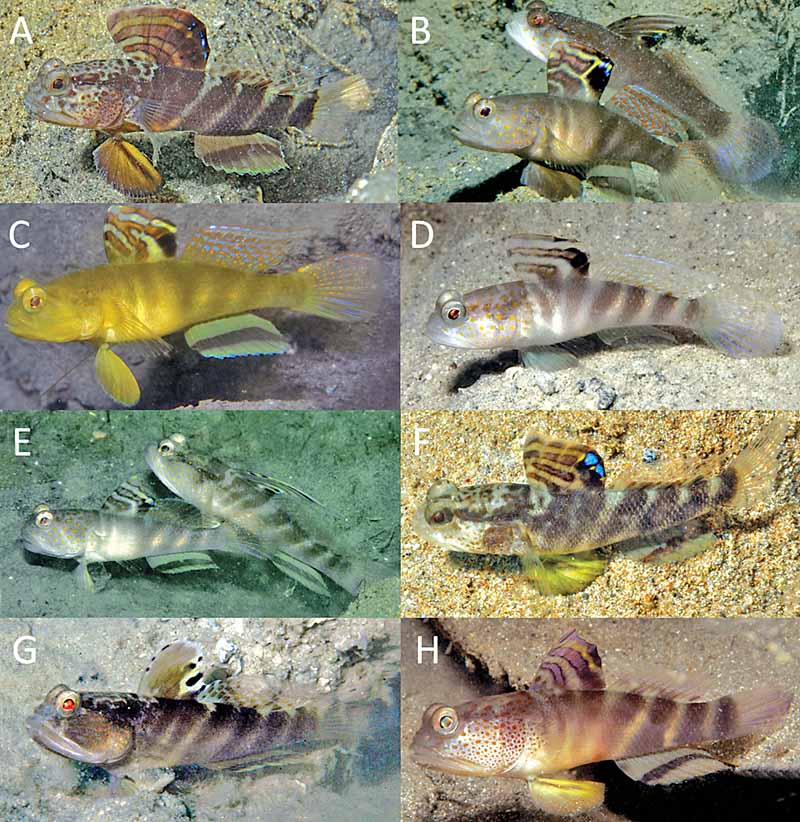Mahidolia mystacina
(Valenciennes, 1837)
|
Familie: Gobiidae SynonymeGobius mystacinus Valenciennes, 1837
Gobius pulverulentus Kuhl & van Hasselt, 1837
Mahidolia duque Smith, 1947
Waitea buchanani Rao, 1972 Lokale Bezeichnung |
 Mahidolia mystacina -- (C) G.R. Allen (2019) in: Journal of the Ocean Science Foundation, 32: 79-88. (A) ca. 60 mm SL, Milne Bay, Papua Neuguinea; (B) ca. 50 mm SL, Milne Bay, Papua Neuguinea; (C) ca. 45 mm SL, Milne Bay, Papua Neuguinea; (D) ca. 40 mm SL, Guadalcanal, Solomonen; (E) ca. 50 mm SL, Provinz Milne Bay, Papua Neuguinea; (F) ca. 30 mm SL, Anilao, Philippinen; (G) ca. 45 mm SL, Palawan, Philippinen; (H) ca. 60 mm SL, Yap, Micronesien |
Typen
Holotypus: MNHN 0000-2967 .
Siehe: Eschmeyer, W.N., Fricke, R. & Van der Laan, R. (eds.) 2024. Catalog of Fishes electronic version
Typusfundort: Java, Indonesien.
Etymologie
.
Verbreitung
Indo-Pazifik: Ostafrika südlich bis Delagoa Bay, Mosambik und östlich bis zu den Gesellschaftsinseln, im Norden bis Südjapan (?), im Süden bis zum nördlichen Australien und Samoa.
IUCN Status

EX Extinct (ausgestorben)
EW Extinct in the Wild (in der Natur ausgestorben)
CR Critically Endangered (vom Aussterben bedroht)EN Endangered (stark gefährdet)
VU Vulnerable (gefährdet)
NT Near Threatened (potenziell gefährdet)
LC Least Concern (nicht gefährdet)
RE Regionally Extinct (regional oder national ausgestorben)DD Data Deficient (ungenügende Datengrundlage)
NE Not Evaluated (nicht beurteilt)
LC Least Concern (nicht gefährdet)
Gefahren für diese Art: Mahidolia mystacina kommt gelegentlich im Zierfischhandel vor. Jede anthropogene Aktivität, die die Lebensräume von Mangroven und Küsten-Wattenmeer betrifft, kann eine Bedrohung darstellen. Das Ausmaß solcher Bedrohungen ist jedoch unbekannt. Es sind keine anderen größeren Bedrohungen bekannt.
Literatur
- Cuvier, G. & Valenciennes, A. 1837. Histoire naturelle des poissons. Tome douzième. Suite du livre quatorzième. Gobioïdes. Livre quinzième. Acanthoptérygiens à pectorales pédiculées. 12: i-xxiv + 1-507 + 1 p., Pls. 344-368. BHL Zitatseite [:124, Autor: Valenciennes !! als Gobius mystacinus]
- Macleay, W. 1878. The fishes of Port Darwin. Proceedings of the Linnean Society of New South Wales, 2 (4): 344-367, Pls. 7-10. (BHL) Zitatseite [:357, Pl. 9 (fig. 2), !! als Gobius maxillaris]
- Tanaka, S. 1915. Ten new species of Japanese fishes. Dobutsugaku Zasshi [Zoological Magazine Tokyo], 27 (325): 565-568. [auf japanisch] Zitatseite [:567, !! als Waitea parvida]
- Smith, H.M. 1932. Contributions to the ichthyology of Siam. I. Descriptions of a new genus and three new species of Siamese gobies. Journal of the Siam Society, Natural History, Supplement 8 (4): 255-262, Pl. 23. Zitatseite [:256, Pl. 23 (top), Autoren: Smith & Koumans !! als Mahidolia normani]
- Smith, J.L.B. 1947. New species and new records of fishes from South Africa. Annals and Magazine of Natural History, (Series 11) 13 (108) (art. 77): 793-821. Zitatseite [:812, !! als Mahidolia duque]
- Rao, V.V. 1972. A new fish of the family Gobiidae from Godavari estuary. Journal of the Bombay Natural History Society, 69 (1): 130-133. Zitatseite [:130, Fig. 1, !! als Waitea buchanani]
- Yanagisawa, Y. 1978. Studies on the interspecific relationship between gobiid fishes and snapping shrimp. I. Gobiid fishes associated with snapping shrimps in Japan. Publications of the Seto Marine Biological Laboratory, 24 (4/6): 269-325, Pls. 1-3. (Handle) Zitatseite [:310, als Mahidolia mystacina; Waitea parvida als Synonym]
- Wu, H.-L. & Lin, S.-D. 1983. On a new species of Oligolepis Bleeker (Perciformer [sic]: Gobiidae) from China. Journal of Fisheries of China, 7 (1): 83-86. Zitatseite [:83, !! als Oligolepis fasciatus]
- Masuda, H., Amaoka, K., Araga, C., Uyeno, T. & Yoshino, T. (Eds.) 1984. The fishes of the Japanese Archipelago. Tokai University Press, Tokyo, xxii + 437 pp. Zitatseite [:262, Autor: Hayashi als Mahidoria mystacina]
- Maugé, A.L. 1986. Atherinidae (pp. 277-279), Ambassidae (pp. 297-298), Kuhliidae (pp. 306-307), Gobiidae (pp. 358-388), Eleotridae (pp. 389-398), Periophthalmidae (pp. 399-401). In:
- Daget, J., Gosse, J.-P. & Thys van den Audenaerde, D.F.E. 1986. Checklist of the freshwater fishes of Africa (CLOFFA). ISNB Bruxelles, MRAC Tervuren, ORSTOM Paris. 2: i-xiv + 1-520. Zitatseite Zitatseite [:386 als Waitea mystacina; Synonyme]
- Talwar, P.K. & Jhingran, A.G. 1991. Inland fishes of India and adjacent countries. In 2 vols. Oxford & IBH Publishing Co., New Delhi, Bombay, Calcutta. v. 1-2: i-xvii + 36 unnumbered + 1-1158, 1 pl, 1 map. Zitatseite [:938, Waitea buchanani als Synonym]
- Kottelat, M. 2013. The Fishes of the Inland Waters of Southeast Asia: A Catalogue and Core Bibliography of the Fishes Known to Occur in Freshwaters, Mangroves and Estuaries. The Raffles Bulletin of Zoology, Supplement No. 27: 1–663. (PDF) Zitatseite [:412, Oligolepis fasciatus als Synonym]
- Allen, G.R. & Erdmann, M.V. 2019. Mahidolia paucipora, a new species of shrimpgoby (Teleostei: Gobiidae) from Papua New Guinea. Journal of the Ocean Science Foundation, 32: 79-88. (doi) Zitatseite [: 87, Fig 7, Farbfotos, Vergleich, unterschiedliche Standortvarianten]